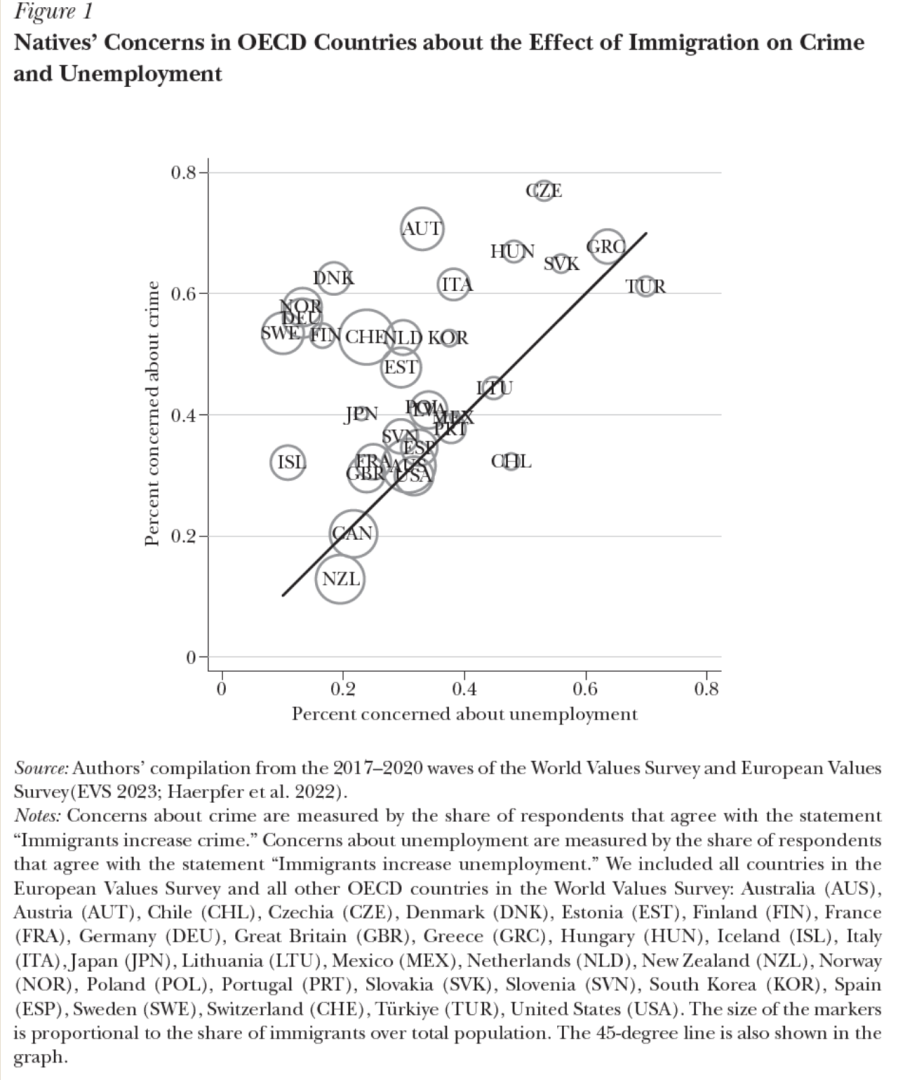Comments
- No comments found

In public opinion polls, one of the primary concerns about rising levels of immigration is the extent to which it might increase crime rates.
But several puzzles arise here. The evidence that immigration systematically leads to an increase in local crime rates turns out to be meager. However, Olivier Marie and Paolo Pinotti explore these issues “Immigration and Crime: An International Perspective” in the Winter 2024 issue of the Journal of Economic Perspectives (38:1, 181-200).
(Full disclosure: I’ve been Managing Editor of the JEP since 1986. All articles in JEP from the most recent issue back to the first have been freely available online for the last decade or so, compliments of the publisher, the American Economic Association.)
As a starting point, it turns out that when you ask people about their concerns over immigration, in many countries crime is a bigger concern than jobs. In the graph the dark line (the “45-degree line”) shows equal concern about these two issues, like in the United States. But most countries are above that line, showing that more natives in those countries express concerns over crime than over unemployment as a consequence of immigration.

At some level, it wouldn’t be surprising if immigration did lead to a rise in crime, given that immigrants are more likely to be young men with a lower education level than is common in their destination country, and thus limited job prospects. This group tends to be higher-crime. And there is some evidence supporting this belief: the authors note that across a sample of 30 countries, the share of foreigners in the prison population is about double their share of the than overall population. Interestingly, the United States is a major exception to this pattern: here, the share of foreigners in the prison population is about half the share in the overall population. Of course, to some extent this comparison will reflect that the US has a larger share of its native-born population in prison than most countries.
However, trying to figure out how much immigrants increase the crime rate is a harder question. For example, it’s possible that immigrants might tend to move to places with more job opportunities, thus tending to hold down the crime rate, or that the cost to immigrants of getting involved with the criminal justice system might be higher. It’s also possible that when immigrants become criminals, they to some extent crowd out native-born criminals–which could mean that the overall crime rate doesn’t rise. A researcher would like to have a random selection of different levels of immigrants arriving at a random selection of locations, but this social experiment seems unlikely to be carried out.
As Marie and Pinotti explain, the standard approach in this research literature happens in two parts. First, it’s well-known that immigrants have a tendency to locate where other previous immigrants from their country have located. Thus, one can look at where previous waves of immigrants have located and do a projection of where future immigrants will go. The second step is to look at whether immigration across different areas is higher or lower than expected, and to calculate whether these unexpectedly higher or lower rates of immigration are correlated with crime.
This “shift-share” approach, as it is called, is used across a number of areas of economics. It has various built-in assumptions, and the migration and crime data across areas has its own measurement problems. Marie and Pinotti walk through these issues. But the bottom line is that when you apply this approach to data from the United States or various European countries, there doesn’t appear to be any effect of unexpectedly higher or lower immigration on crime rates in a given area.
Of course, immigrants are not a homogenous group. Those with legal status, for example, will find it easier to get jobs. Thus, there is evidence from the US and other countries that when there is an amnesty for illegal immigrants that makes it easier for them to hold jobs, crime rates tend to fall–which in turn suggests that before the amnesty, crime rates for this group were higher. Also, a number of countries have rules that make it harder for immigrants who are asylum-seekers to hold jobs. Evidence from the UK suggests that areas which were randomly chosen to receive immigrant asylum-seekers did have higher crime rates. Thus, the job market prospects of immigrants seem to affect their crime rates.
Marie and Pinotti point out several studies of situations when immigration became an especially salient political issue: a 2009 referendum in Switzerland about whether minarets could be built on new mosques, and a situation in Chile where the number of foreign-born residents with work permits tripled from 2010 to 2017. They note that media coverage of these issues tended to raise public fears of crime by immigrants, although the evidence of actual higher crime rates was lacking. There’s of course no doubt that some immigrants, being human, will commit crimes. But there’s good reason to question how important the risk of higher crime rates should be when thinking about benefits and costs of immigration policy.
Timothy Taylor is an American economist. He is managing editor of the Journal of Economic Perspectives, a quarterly academic journal produced at Macalester College and published by the American Economic Association. Taylor received his Bachelor of Arts degree from Haverford College and a master's degree in economics from Stanford University. At Stanford, he was winner of the award for excellent teaching in a large class (more than 30 students) given by the Associated Students of Stanford University. At Minnesota, he was named a Distinguished Lecturer by the Department of Economics and voted Teacher of the Year by the master's degree students at the Hubert H. Humphrey Institute of Public Affairs. Taylor has been a guest speaker for groups of teachers of high school economics, visiting diplomats from eastern Europe, talk-radio shows, and community groups. From 1989 to 1997, Professor Taylor wrote an economics opinion column for the San Jose Mercury-News. He has published multiple lectures on economics through The Teaching Company. With Rudolph Penner and Isabel Sawhill, he is co-author of Updating America's Social Contract (2000), whose first chapter provided an early radical centrist perspective, "An Agenda for the Radical Middle". Taylor is also the author of The Instant Economist: Everything You Need to Know About How the Economy Works, published by the Penguin Group in 2012. The fourth edition of Taylor's Principles of Economics textbook was published by Textbook Media in 2017.
Leave your comments
Post comment as a guest